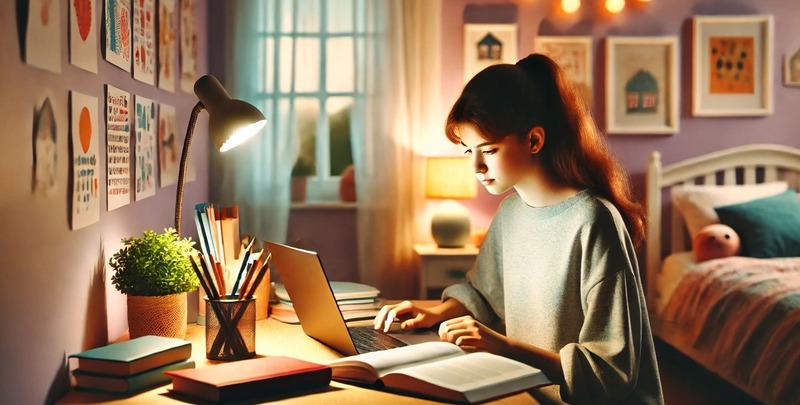What is the Best Light for Studying?
What is the Best Light for Studying?
Choosing the right lighting for studying is more important than most people realize. The quality of light in your study space can greatly affect your focus, reduce eye strain, and improve overall productivity.
Whether you're studying during the day or late at night, the right lighting can make a huge difference in how well you concentrate and stay productive.
In this article, we'll explore the best lighting options for a home study area. We'll look at natural vs. artificial light, color temperature, and other features that can enhance your study experience. Finding the perfect lighting setup can transform how you study and help you reach your academic goals more efficiently.
Natural Light vs Artificial Light
Natural light is often considered the ideal choice for studying. Exposure to daylight can boost your mood, increase energy levels, and improve concentration, making it a great environment for focused learning.
If your study area has access to natural light, try to position your desk near a window to take full advantage of it.
However, relying solely on natural light isn't always possible. During the evening or in rooms with limited sunlight, artificial lighting becomes essential. It provides consistent illumination, allowing you to study comfortably at any time of day.
When choosing artificial lights, look for options that mimic natural daylight as closely as possible. LED lights are a popular choice because they offer bright, clear light that’s easy on the eyes and helps maintain focus over long periods.

Types of Artificial Lighting for Studying
Selecting the right type of artificial lighting is key to creating an effective study space. Here are some of the most common options:
- LED Lights: Energy-efficient and long-lasting, LED lights provide bright, flicker-free illumination that reduces eye strain. They’re perfect for long study sessions.
- Fluorescent Lights: These are commonly used in classrooms and offices. They offer even lighting over a large area but may have a slight flicker that some find distracting.
- Halogen Lights: These produce a bright, white light similar to natural daylight, which is great for focused tasks. However, they tend to get hot, so they’re not ideal for all spaces.
- Smart Bulbs: These allow you to adjust brightness and color temperature via an app or voice control. This flexibility makes them ideal for different study needs throughout the day.
Each type of lighting has its own benefits, so choose based on your specific study habits and environment.
Color Temperature and Its Impact
Understanding color temperature is essential for creating a comfortable and effective study environment. Color temperature is measured in Kelvin (K), and it affects how you feel and focus.
Here's how different temperatures affect your study:
- Warm Light (2700K–3000K): Soft and yellow, this creates a cozy atmosphere. Great for relaxing, but not ideal for intense focus or long study sessions.
- Neutral Light (3500K–4100K): Balanced and clear, this is often used in offices and study areas. It reduces eye strain and supports better concentration.
- Cool Light (5000K–6500K): Bright and blue-toned, like daylight. Perfect for keeping alert during the day, but may be too harsh for evening study sessions.
Choose a color temperature that matches your study schedule and personal preferences for maximum comfort and focus.
The Importance of Adjustable Lighting
Adjustable lighting is a must-have in any study space. It allows you to customize the brightness and direction of light based on your needs. Dimmable lights are especially useful, as they let you fine-tune the brightness depending on the time of day or task at hand.
A desk lamp with an adjustable arm or neck is also beneficial. It lets you direct the light exactly where you need it—whether you're reading a book or working on a laptop. This targeted lighting helps eliminate shadows and glare, ensuring your workspace is well-lit from every angle.
By using adjustable lighting, you can create a flexible and comfortable study environment that adapts to your needs, improving both focus and productivity.

Additional Features to Consider
When choosing the best light for studying, there are several other features that can significantly impact your experience:
- Adjustable Brightness: Look for dimmable lights that let you change the intensity based on your needs. This helps reduce eye strain during long study sessions.
- Flexible Design: Lamps with adjustable arms or rotating heads allow you to direct light precisely where it’s needed. Ideal for reading, writing, or working on a computer.
- Glare Control: A built-in diffuser or shade can reduce glare, which is especially important when working on screens or glossy surfaces.
- Smart Features: Some lamps come with smart controls like voice activation or app-based adjustments. These add convenience and make it easier to switch between lighting modes.
- Energy Efficiency: Choose LED bulbs that save power and last longer, helping you save money over time.
These extra features can make a big difference in your study environment, helping you stay focused and comfortable for longer periods.
Enhance Your Ability to Concentrate
Selecting the right lighting is crucial for creating a productive and comfortable study space. Whether you prefer natural light or rely on artificial options, understanding color temperature and the benefits of adjustable lighting can help you stay focused and reduce eye strain.
Adding features like anti-glare designs or blue light filters can further improve your study experience. With the right lighting setup, you can boost your concentration and achieve your academic goals more effectively.
Please note: This information is for general advice only. Regulations may vary by location, so please consult local authorities or a professional before making any changes. See our Terms & Conditions here.
What makes Alloy Steel Plates durable is the normalizing and annealing processes that they undergo to get rock hard surfaces. While annealing toughens the surface with the removal of internal stresses, giving Alloy Steel plates a uniform structure.Consequently, these treatments furnish heavy-duty plates which can survive mighty blows.
Alloy Steel Plates by us are marvellously malleable, they provide excellent forming properties, being cut and bent into many shapes. The process of normalizing and tempering garners Alloy Steel plates with firm but elastic bodies due to re-heating and cooling. Eventually, they acquire excellent weldability, welded readily to form superstructures.
The Alloy Steel Sheets plates are available in a wide variety of shapes, thickness, and dimensions.Chrome Moly Sheets plates are highly acclaimed in the market due to its features such as durability, easy to install and require low maintenance. The alloy Steel Plate is used in a wider range of industrial applications. The alloy steel is mostly used in engineering projects, steel industry etc. alloy steel offers longer service life, corrosion resistance, and superior strength.
Alloy Steel Plate,Medium Thick Alloy Steel Plate,Hot Rolled Alloy Steel Plate,4130 Alloy Steel Plate
SHANDONG HUITONG STEEL CO.,LTD , https://www.cnmetalsupply.com